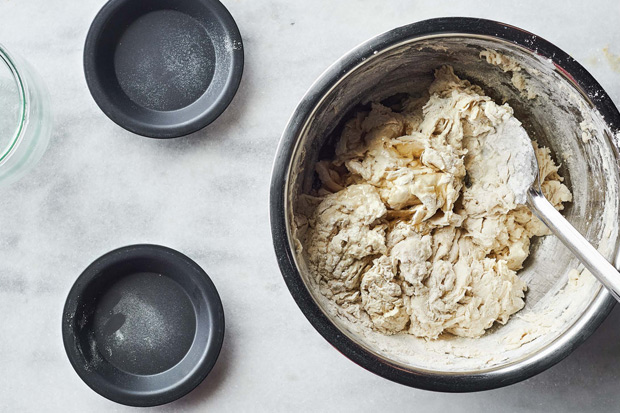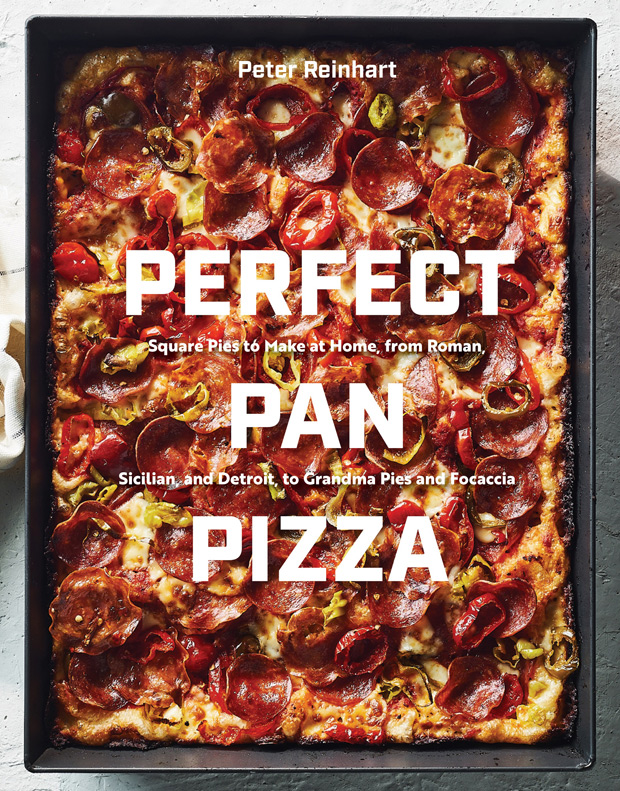Recipe
April 25, 2019
White Flour Dough

Try this White Flour Dough recipe from the cookbook Perfect Pan Pizza by Peter Reinhart.
 This first dough, which makes a 100 percent white flour pizza crust, is the most popular, but the ones that follow, Whole Grain Country-Style Dough (page 29), with variable amounts of whole grain flour, and Naturally Leavened Dough (page 33) are growing in popularity as interest in whole grain and sourdough baking increases. My suggestion is to first master this white flour dough and then branch out and try the others.
This first dough, which makes a 100 percent white flour pizza crust, is the most popular, but the ones that follow, Whole Grain Country-Style Dough (page 29), with variable amounts of whole grain flour, and Naturally Leavened Dough (page 33) are growing in popularity as interest in whole grain and sourdough baking increases. My suggestion is to first master this white flour dough and then branch out and try the others.
Note that the formula specifically calls for unbleached bread flour and not Italian double zero flour or all-purpose or high-gluten flour (see box, page 20), though you are free to use these, and adjust the hydration as needed, if you wish.
Since the dough requires at least 12 hours of chilling, I recommend making the dough at least 1 day ahead. On the day you plan to bake, follow the steps according to the type of pizza you are making.
Directions
Yield:
- In the bowl of a stand mixer fitted with the paddle attachment, or in a large mixing bowl, combine the flour, salt and yeast. Add all of the water and mix on slow speed for 30 seconds or stir with a large spoon to form a coarse, shaggy dough. Add the 2 tablespoons of oil, increase the speed to medium (or continue mixing with the spoon or with wet hands), and mix for another 30 to 60 seconds to make a wet, coarse, sticky dough. It may seem too wet to form a cohesive dough at this stage. Let the dough rest for 5 minutes to fully hydrate.
- Increase the mixer speed to medium-high (or continue mixing by hand) and mix for another 30 to 60 seconds to make a smooth, sticky dough. It should be soft, supple and sticky to the touch and offer a little resistance when pressed with a wet finger.
- Use 1 teaspoon of the extra oil to make a 15-inch-diameter oil slick (see page 31) on the work surface. Rub some oil on a plastic bowl scraper and on your hands and use the scraper to transfer the dough to the oil slick. Stretch and fold the dough as shown on page 22. Cover the dough with a bowl and let it rest for 2 to 5 minutes. Repeat the stretch and fold (rub more oil on the work surface as needed), cover the dough and let it rest for 2 to 5 minutes. Then repeat the stretch and fold, cover with the bowl and again let it rest for 2 to 5 minutes. Perform a fourth and final stretch and fold to make a smooth ball of dough. The dough will have firmed up after each stretch and fold and will now be soft, smooth, supple and somewhat sticky but firm enough to hold together when lifted. Transfer the dough to a lightly oiled bowl, cover with plastic wrap and refrigerate for 12 to 72 hours.
- Pan the dough on the day you plan to bake your pizzas (or on the day before, see page 12). If making focaccia, Sicilian-style, Grandma or Roman-style pizza, follow the instructions for panning on page 139. For deep-pan pizza, weigh and divide the dough according to the size of your pans and follow the instructions for panning on page 15.
What exactly does the term coarse, shaggy dough mean?
During the early stages of mixing, while the flour is absorbing the liquid (a.k.a. hydrating), the dough appears coarse and almost lumpy (see photo, page 26). The more it mixes, the smoother it gets. This coarse appearance is referred to as shaggy, as in the look of a shag rug. Not only will additional mixing smooth it out, but so will the stretching and folding. In my mixing method, it’s important to get the dough to the shaggy stage during the first minute of mixing, before briefly kicking up the speed to medium (or, if mixing by hand, to increase the intensity of the kneading or stirring). Once the dough becomes somewhat smoother, you can move on to stretching and folding.
Excerpted from Perfect Pan Pizza: Square Pies to Make at Home from Roman, Sicilian, and Detroit, to Grandma Pies and Focaccia by Peter Reinhart. Copyright © 2019 by Peter Reinhart. Photographs copyright © 2019 by Johnny Autry. Published in the United States by Ten Speed Press, an imprint of the Crown Publishing Group, a division of Penguin Random House LLC, New York. Reproduced by arrangement with the Publisher. All rights reserved.

